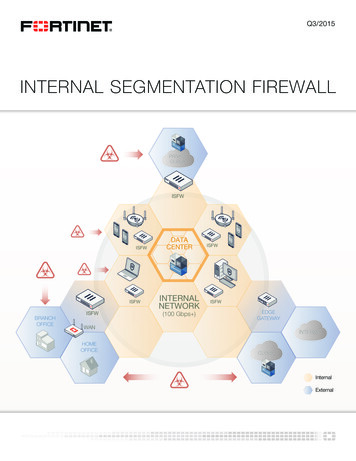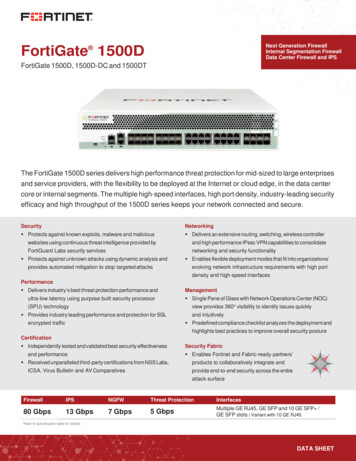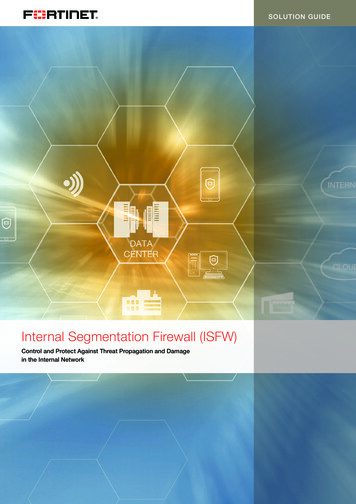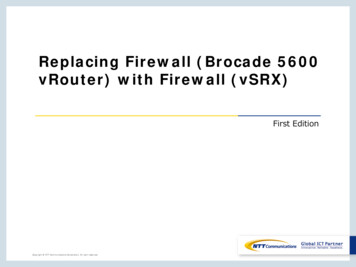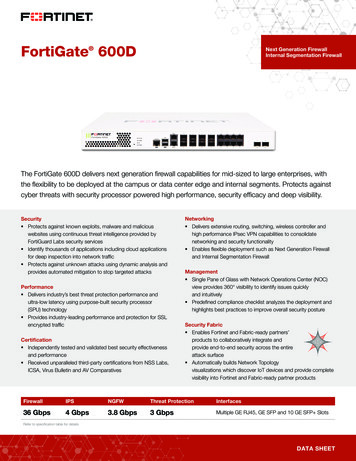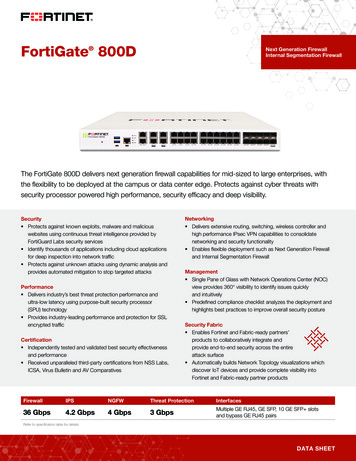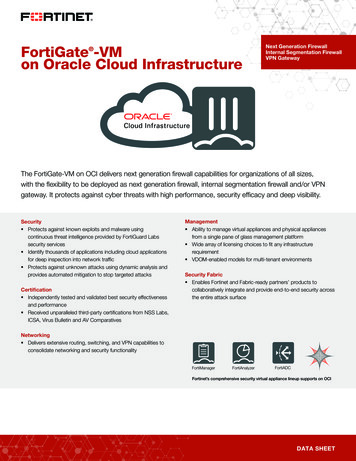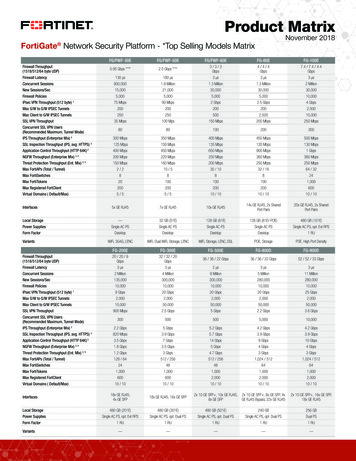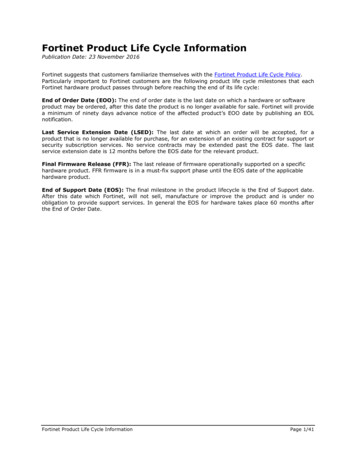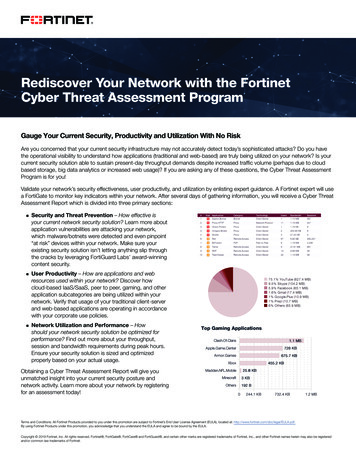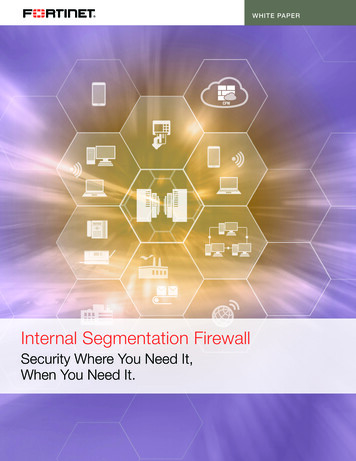
Transcription
WHITE PAPERInternal Segmentation FirewallSecurity Where You Need It,When You Need It.
WHITE PAPER: INTERNAL SEGMENTATION FIREWALL: SECURITY WHERE YOU NEED IT, WHEN YOU NEED IT.Internal Segmentation FirewallSecurity Where You Need It, When You Need It.Table of ContentsExecutive Summary3Increasing Attack Surfaces3Infrastructure Reality4Internal Segmentation Firewall5Architecture Overview7Ecosystem Connectivity7Internal Segmentation Assessment8ISFW Reference Architecture9Conclusionwww.fortinet.com122
Executive SummaryArea 51 is one of the most secure facilities in theworld. While it has acres of land surrounding the base,a perimeter fence, keycard, door locks, biometricscanners, and multiple alarms—none of these featuresindividually keeps Area 51 safe. Each one is a strandthat helps to weave an exceptionally strong web ofsecurity for protection inside and out.Enterprise networks can benefit from the same kind of securityphilosophy. While an edge firewall can do an excellent job ofprotecting the network perimeter, it can’t help with attacks onthe inside, after a breach occurs.Today’s threats are designed to slip past traditional edgefirewalls to reach the unprotected internal network. The notionof the “Trusted” internal network is now archaic. Relying onperimeter security is no longer sufficient as there are manyvectors that can circumvent the perimeter firewall. BYOD,wireless, and unprotected wired access are just a few ways thatmalicious code can make its way into an internal network.Fortinet believes that there is a strong need to addressinternal network security before the quantity of networks anddevices makes it too complex to introduce new componentsor establish a new architecture. Based on the feedback fromour customers, we know that companies of all sizes are facingsimilar challenges and are looking for an immediate solution.The good news is that Enterprises can do a lot more to protecttheir assets and data from within.www.fortinet.comHistorically, trying to implement internal security has beenproblematic due to high performance requirements and/or limited capital resources. But today, Fortinet has solvedthis problem with a new class of device that removes theconstraints and limitations of what a firewall can do for theenterprise. The Internal Segmentation Firewall (ISFW) isdesigned to protect network segments from malicious codethat makes its way to the internal network.Fortinet’s ISFW architecture delivers maximum performanceand maximum security, while still offering the flexibility ofbeing placed anywhere in the enterprise. Fortinet’s enterprisemanagement solution creates simple ways to manage theoverall policy for multiple devices securing the enterprise’sinternal network security.This white paper presents both a design approach as well asa reference architecture for implementing an ISFW strategy foryour enterprise with Fortinet’s proven security solutions.Increasing Attack SurfacesThreat vectors are coming in increasing numbers, and frommultiple directions. Given the advent of many new and not sonew technologies and practices within the enterprise, mostnetworks have not adopted new strategies to deal with thecurrent situation. As a result, there seems to be more exposurethan ever to security threats.3
WHITE PAPER: INTERNAL SEGMENTATION FIREWALL: SECURITY WHERE YOU NEED IT, WHEN YOU NEED IT.Cloud computing has been on the rise for several years now,but the ability to see what’s coming in and out of them has notimproved. For example, SaaS vendors sell a service, hostedexternal to the enterprise. They are most likely not providing thedetails of their implementation nor the “secret sauce” of theirtechnology—customers must trust that the vendor is able todeliver the service in a secure manner. This is not unlike anyother type of traditional B2B trust relationship—assumptionsare often made that the partner is doing all the right things interms of security.Even if one assumes that the partner’s security efforts areeffective, it’s still a black box. Many cloud computing companiescan serve as a gateway in and out of your enterprise network—one that the end customer has no visibility into. Is intellectualproperty being exfiltrated? Is malicious code flowing in? Withoutvisibility, there is no possibility for attack prevention, let alonedetection or forensics.The issue of BYOD is another fact of life for enterprise networks,regardless of whether or not the policy is officially embraced.The blurred line between what’s part of the enterprise andwhat’s not has never been more unclear. The ways in whichfirewall administrators assume a level of security or a zoneof trust are often rooted in security hardening philosophiesfrom the early 2000s. User laptops, phones, and wirelessaccess points are all implicitly placed in a zone of trust basedsolely on their physical locality to the network. This results ina level of trust being given to devices of which the enterpriseadministrator has no control. The countless number of devicesthat are introduced into modern networks make for everincreasing challenges for policing and control.Virtualization has also had an unexpected side effect of makingsecurity operations more difficult. The transitory nature of a lot ofvirtual machines makes doing any routine security audits difficult,if not constantly outdated. Movement and workload shifts withinthe virtual environment can spell disaster should a host becomeinfected and security controls not dynamically shifted with thevirtual environment. Synergies between security controls andvirtualized environments can help mitigate those risks.These few example cases offer a sample of the attack surfacesthat modern networks face. While most modern networksappear with a generally similar set of tools protecting theiredge, internal networks are much more varied in componentsand operation—rendering the implementation of security toolsmore complex and often times less effective. These are clearindicators that the Internet edge is no longer the only place thatneeds to be secured.www.fortinet.comInfrastructure RealityThere is always a great difference between security in theoryand security in practice. This isn’t to say that there are no toolsand mechanisms that can be put in place to limit exposure, orprocesses that can be enacted to reduce the attack surface.For cloud services, one can manage which SaaS providersare supported and find ways of improving the visibility of whatgoes in and out. BYOD can be managed with on-box agents,network access control, and corporate policies. Virtualization isa tougher nut to crack, not just because it’s virtual, but becauseof who maintains it. A virtual host can be secured much inthe same way a physical host is, but teams responsible forvirtual environment management need to consider security asa forefront item of importance. Virtual environments can betransitory, and this makes it harder to clean an infected virtualhost because malicious code can re-emerge suddenly in anunexpected part of the network.Theoretically, many of these problems can be addressed;in reality, it’s not always practical or even possible to do so.Tactically addressing security issues with point products and/or patchwork solutions often results in operational complexity.Upgrade cycles can become convoluted and ripple throughmultiple components due to interoperability dependencies—even requiring updates to every piece of the infrastructure. Lastand most important, the end goal of every enterprise running abusiness—making a theoretical “best” the enemy of the “good”can disrupt core operations indefinitely.Another truth that should be acknowledged concerns operatingsystems. It’s a security best practice to keep the networkoperating system up to date with all of the latest securitypatches. Enterprises know this, but there are times when thissimple practice can become difficult or even impossible.The enterprise resource planning (ERP) system can be one ofthe most business critical systems to maintain. It’s composedof many components and uses a number of protocols (bothopen and proprietary) to do its job. There will be supported OSversions for each of the components, but not all of them are thesame. There may be different underlying software stacks thatare fully integrated within each component.When a new security vulnerability is discovered, there canoften be an OS-level patch or even an application patch thataddresses the problem. But the new OS patch may not besupported yet by various ERP components or IT may not havethe ability to update the component’s underlying software tothe latest release. For example, perhaps the new OS version4
WHITE PAPER: INTERNAL SEGMENTATION FIREWALL: SECURITY WHERE YOU NEED IT, WHEN YOU NEED IT.for one component is incompatible with another component.These kinds of very common conundrums can lead to a choicebetween living with a known but unaddressed security flaw in amission critical system or having that system break altogether.there is physical and logical separation required between usercommunities and core infrastructure (where edge firewallstypically reside). This poses a great challenge in trying to gainmore visibility into what is going on inside a network.“Performance versus cost” has been another reality thatenterprises must face. LAN speeds found on the internal sideof the network are orders of magnitudes higher than those atthe edge. To keep up with higher traffic rates on the LAN, manyenterprises choose speed over security. Until now, enterprisenetworks have not been able to seriously consider internalsegments as a viable place to put any stateful security device.Even in the cases that offered the possibility, a compromisewas always required that reduced security functionality toincrease speed. Furthermore, the cost of a device that couldsimultaneously meet security, control, and speed requirementswould typically be out of reach for most enterprises. Fortinetnow provides secure, cost-effective, and high performingsecurity devices that are a perfect fit for this kind of enterpriseclass internal network security.While one might assume that the only way into the network isvia the edge firewall, the reality is that there are many ingressand egress points on the network—and not all of them aregoverned by an edge firewall. Another assumption is that allattacks come from the outside. But in today’s environment, anattack from the inside (knowingly or unknowingly) is almost aslikely as one that originates from the outside.Security can be achieved with different mechanisms. Visibilitytools notify you of incidents so that action can be taken.Controls help you stop insecure behaviors before they start.Mitigation provides clean-up after something happens.Enterprises often make specific choices where they want tofocus efforts, but a maximum level of all three would be theideal solution. But even that core security balance must beweighed against the operational needs of running a business.Internal Segmentation FirewallSegmentation is not new, but effective segmentation has notbeen practical. In the past, performance, price, and effortwere all gating factors for implementing a good segmentationstrategy. But this has not changed the desire for deeper andmore prolific segmentation in the enterprise.An edge or border firewall at the perimeter of the networkis a security best practice. These devices historically haveprotected against known external threats. More and more,edge firewalls are looking deeper at a broader spectrum ofrelatively new threats that try to enter (or exit) networks at theedge. While it’s still critical to have an optimum of security atthe edge (and Fortinet delivers best-in-class products to doexactly that), security at the perimeter can only spot things thatcross that threshold. In addition, the edge firewall is often notdirectly connected to end user network segments. Typicallywww.fortinet.comWith no other safeguards beyond perimeter protection inplace, once something malicious has internal access to thenetwork there is little to stop it from eventually making it tocritical systems. Until recently, very little thought had been putinto firewalling the internal network due to the aforementionedtechnical challenges.Many networks have a large flat layer 2 (L2) infrastructurebehind the firewall, where everyone is on one large network withlittle to no segmentation. This type of topology is typically notsuited for introducing additional traditional layer 3 firewalls asthere are no obvious segmentation points. In larger enterprisenetworks, there are often a few levels of layer 3 (L3) networksegments, but still there are large L2 flat networks segmentsbelow. Most enterprises treat these different segments thesame, often having no security between them, depending solelyon the edge firewall to do the protection for the entire network.The L3 portions of the network might have some existingsecurity, but typically edge firewalls are where the largestinvestment in security happens. The L3 gateways provide asingle point in which one internal network can gain access toanother internal network. This is what’s known as a North/Southsegment. These points are fairly easy to identify in an enterprisenetwork and provide a natural location for segmentation.The L2 portions of the network almost never have any securityassociated with them. Unlike the L3 portions of the network,there is often no obvious single point in which one part of the L2network talks to another part of the L2 network. These portionsare normally large aggregation switches designed for speed.The switches themselves don’t include any places for easyinternal segmentation, but some segmentation can be donebetween different L2 switches on a network. These locationsfor placing some controls within an L2 network are called East/West segments. Once an intruder makes it into one of these5
WHITE PAPER: INTERNAL SEGMENTATION FIREWALL: SECURITY WHERE YOU NEED IT, WHEN YOU NEED IT.areas, then everything within that area is wide open for probingand attack. These are the places where attackers are mostlikely to display malicious behavior out in the open becausetraditionally no one is watching there.An internal segmentation firewall is designed to sit betweentwo or more points on the internal network to allow visibility,control, and mitigation of traffic between those segments.The ISFW can handle traditional North/South segmentation aswell as emerging East/West segmentation. Because of whereit’s placed in the network, ISFWs can focus on looking at anddetecting things that are traversing the internal portions of theenterprise network. Different levels of visibility, control, andmitigation can be utilized in multiple places within the network.Similar to an edge firewall, not all ISFW policies require thesame level of inspection. The ability to put the security whereyou want it, when you want it is one of the greatest benefits ofan ISFW.An internal segmentation firewall can be planned into thenetwork from the very beginning. Being positioned as theNorth/South gateway between different L3 IP blocks is a perfectplace to have security since this is where some segmentationhas already been done in enterprise networks. North/Southsegmentation follows these logical network boundaries. Wherethe network is divided often reflects organizational separationswithin the enterprise, which offers an ideal location for increasedvisibility, control, and mitigation.It’s common for different departments within an enterprise to beplaced on different L3 segments—examples of this could be thecompany’s CFO or a guest on the network. While both of theseusers require extra levels of security, they should not be treatedthe same. The CFO is likely to need critical systems access todeal with the company’s finance—so providing and securingthat access is a large task. The guest on the other hand is anon-trusted source, and therefore should be given no criticalsystem access. In fact, even more security should be applied tothis kind of traffic because it is untrusted. Both of these userscan be secured with an ISFW at the North/South segment forthe L3 guest network and the L3 executive network.However not all segments follow standard network boundaries.In many cases there are devices on the network that havesome differentiated security needs which happen to be inthe same network boundary. This is the emerging East/Westwww.fortinet.comsegmentation. Hosts in the same network boundary sometimesneed additional visibility and control. Historically, this could beaccomplished with an end point solution but unfortunately notall endpoints can use this approach. The common elementis the network—and an ISFW offers the option of placing it inbetween those endpoints.In this situation, IT may have an L2 segment for much of theserver infrastructure, but the duties of each of the serversvaries. It may be the case that CRM server requires access toan internal database machine, but the help desk system doesnot. Because the L2 segment has no singular gateway betweenthese three assets, a set of East/West segments need to becreated within the L2 segment. An ISFW can provide this levelof separation and security for these different critical end points.Having an ISFW that sits in the middle of the network as a L3gateway or bump on the wire enables enterprises to monitordifferent users, give them the access to critical systems theyrequire, or keep them from accessing things they should not.Even critical systems on the network often will benefit fromindividual protection between each other. A single ISFW can beconfigured to handle all of these segments, but because of thevery nature of multiple segments, multiple ISFWs can also bedeployed to spread the load and scale individual segments asnecessary.A Fortinet ISFW can apply security best practices throughouta network. Fortinet provides a best-of-breed security solutionthat delivers the features, performance, and cost that makesinternal segmentation protection a reality for today’s enterprisenetworks.The concept of “least privilege” is an old one—only providingthe access people need and nothing more. It’s a great idea intheory, but it can be very tough to enforce. By having an ISFWat various points within the network, an enterprise gives itselfextra layers of protection from various attack vectors. This inturn enables not only visibility within the network, but also theenforcement that allows “least privilege” to be effective.With a default transparent mode, Fortinet’s ISFW solution canbe rapidly deployed into existing environments with minimaldisruption, while keeping up the multi-gigabit speeds ofinternal networks. Fortinet ISFWs deliver intelligent, adaptive,and advanced threat protection from the inside out, therebyshortening the window of exposure and limiting potentialdamage.6
WHITE PAPER: INTERNAL SEGMENTATION FIREWALL: SECURITY WHERE YOU NEED IT, WHEN YOU NEED IT.Fortinet ISFWs supplement existing NGFW edge deploymentsby providing enhanced visibility throughout the internal network.As hackers attempt to locate assets and data of value,spreading internally from a compromised host to other hosts,a Fortinet ISFW will segment the internal network and restrictlateral movement and propagation of malicious code. Thiscomplementary approach applies seamless, comprehensivesecurity to the entire attack surface—a consistent threatposture, end-to-end across the network.From visibility components like Application Control, FortiView,and the proven threat intelligence of FortiGuard, one canincrease awareness of what’s going through the network. Userauthentication, traffic shaping, and even high-speed securitypolicies control user access to only what’s required. The FortinetISFW can mitigate incidents by using network quarantining,actionable security, and complete logging and auditing.Architecture OverviewIn this architecture, the focus is on security behind the edge
Internal Segmentation Firewall Segmentation is not new, but effective segmentation has not been practical. In the past, performance, price, and effort were all gating factors for implementing a good segmentation strategy. But this has not changed the desire for
